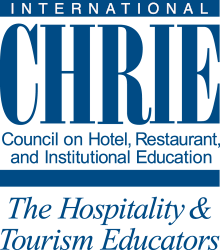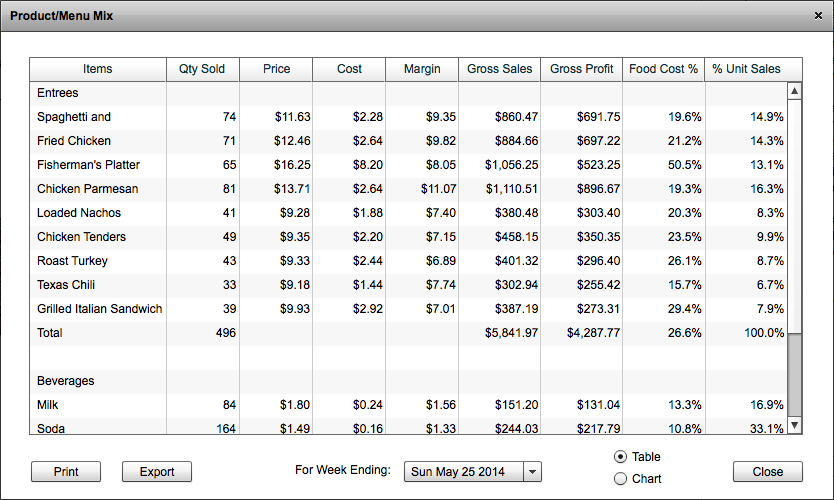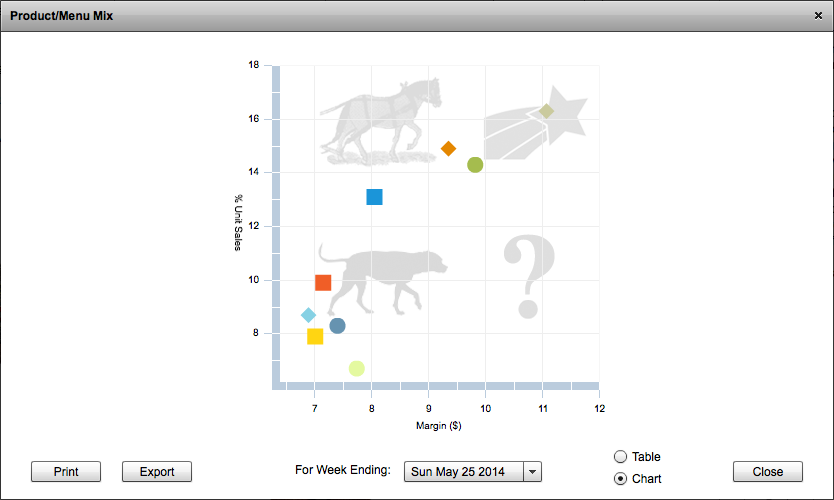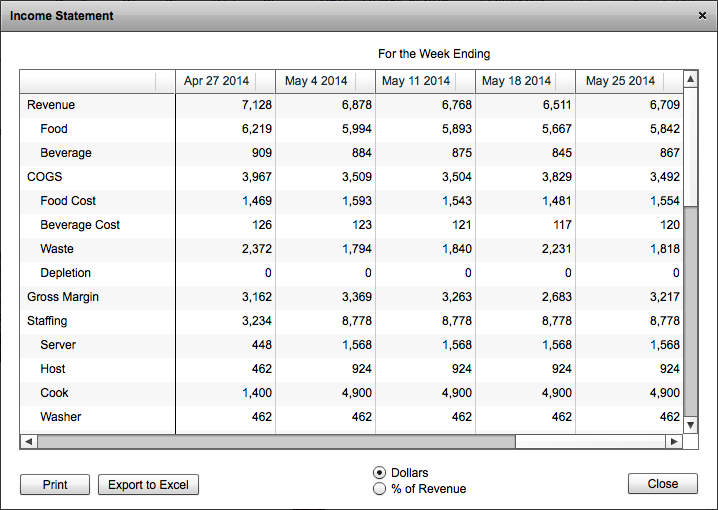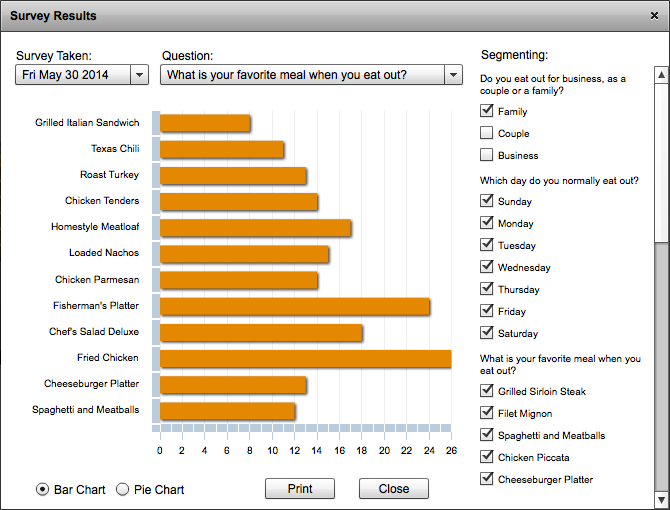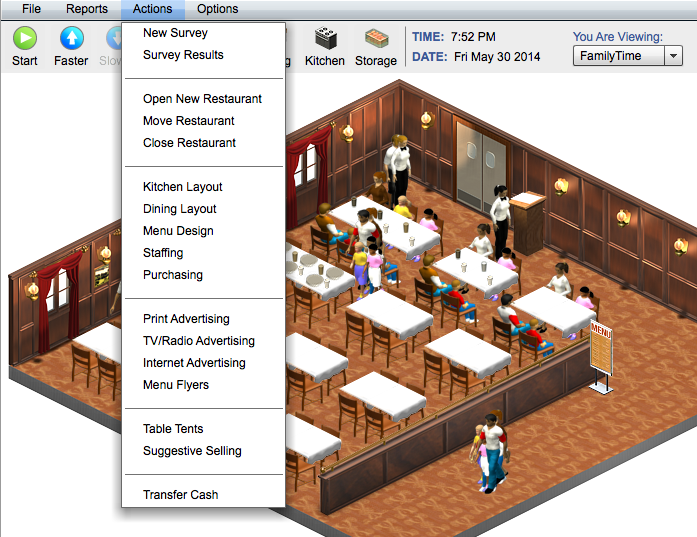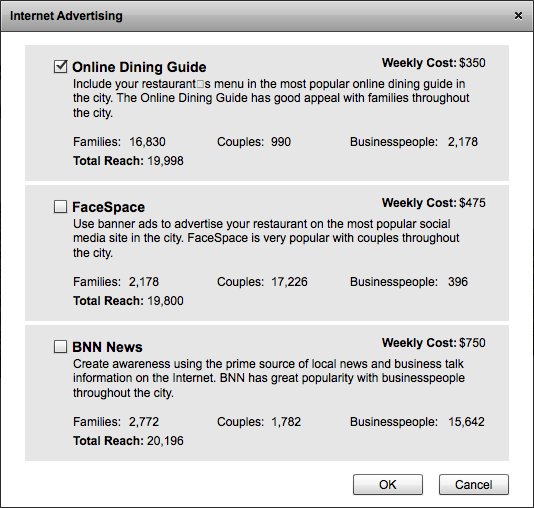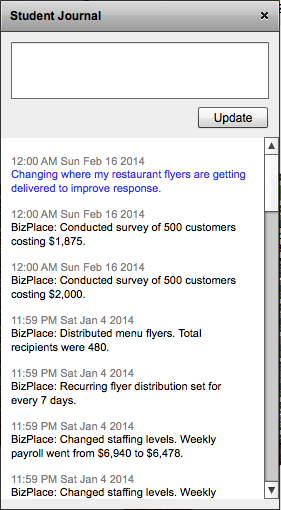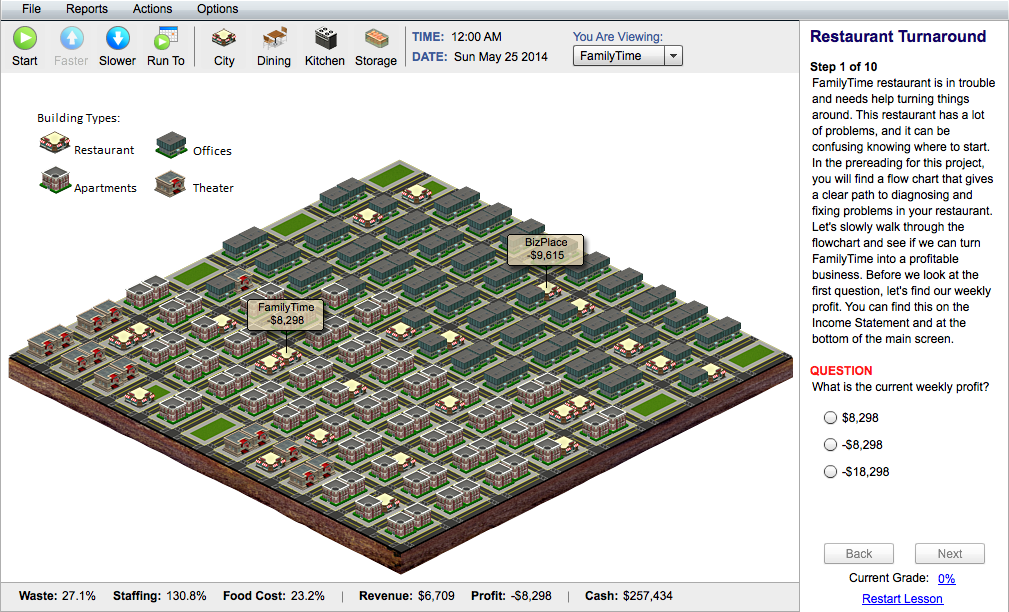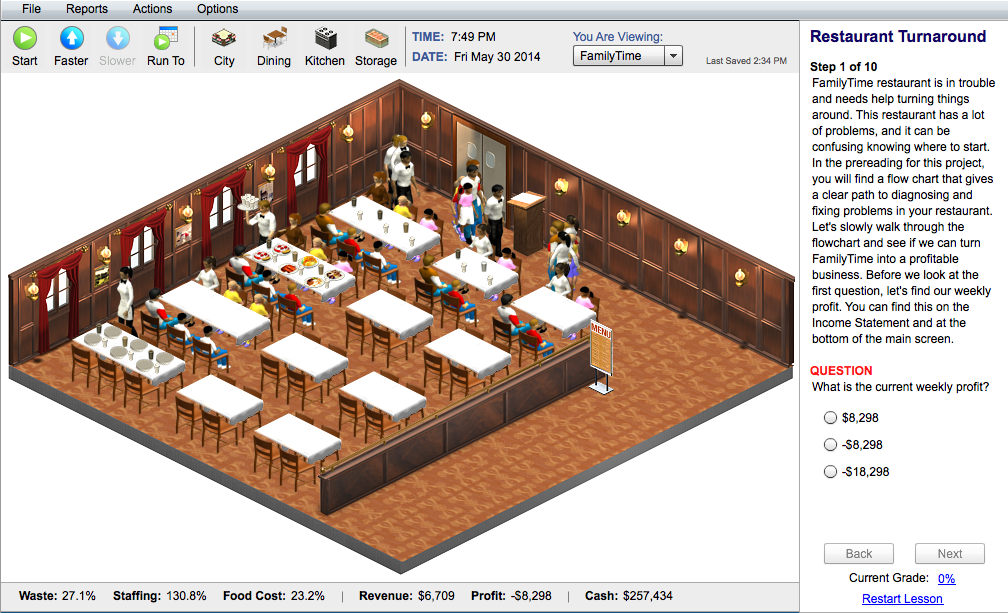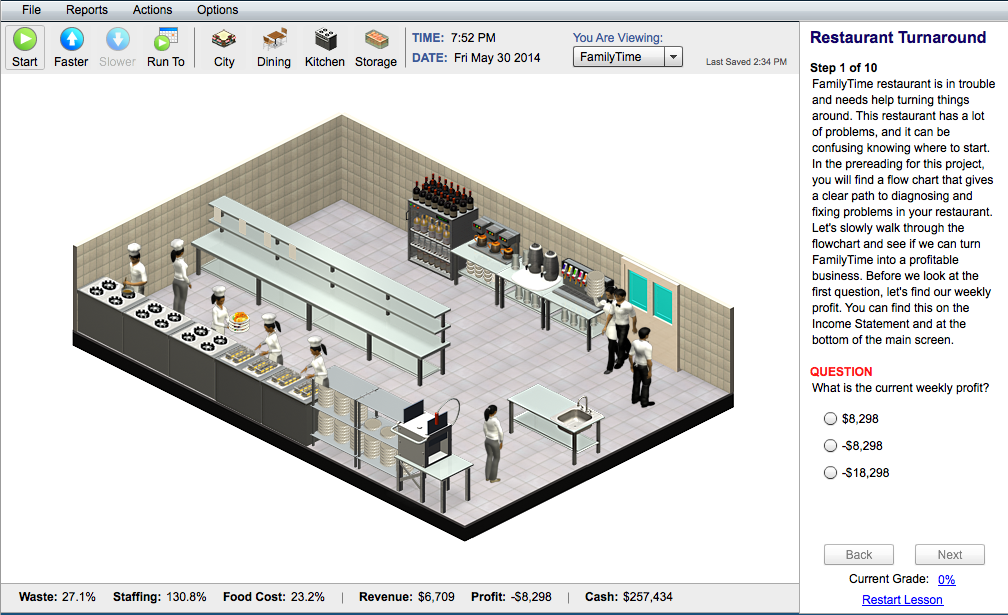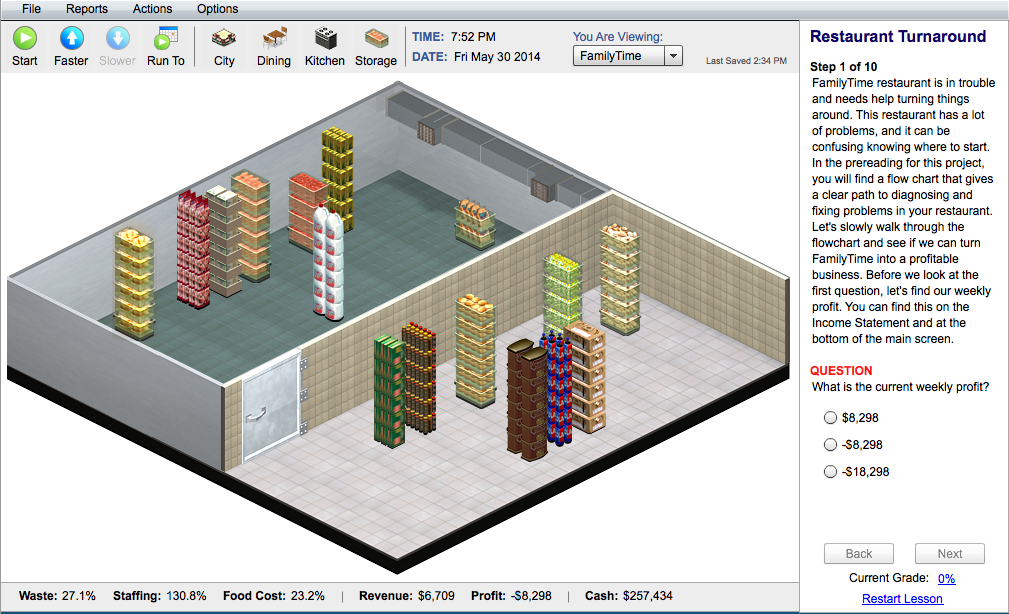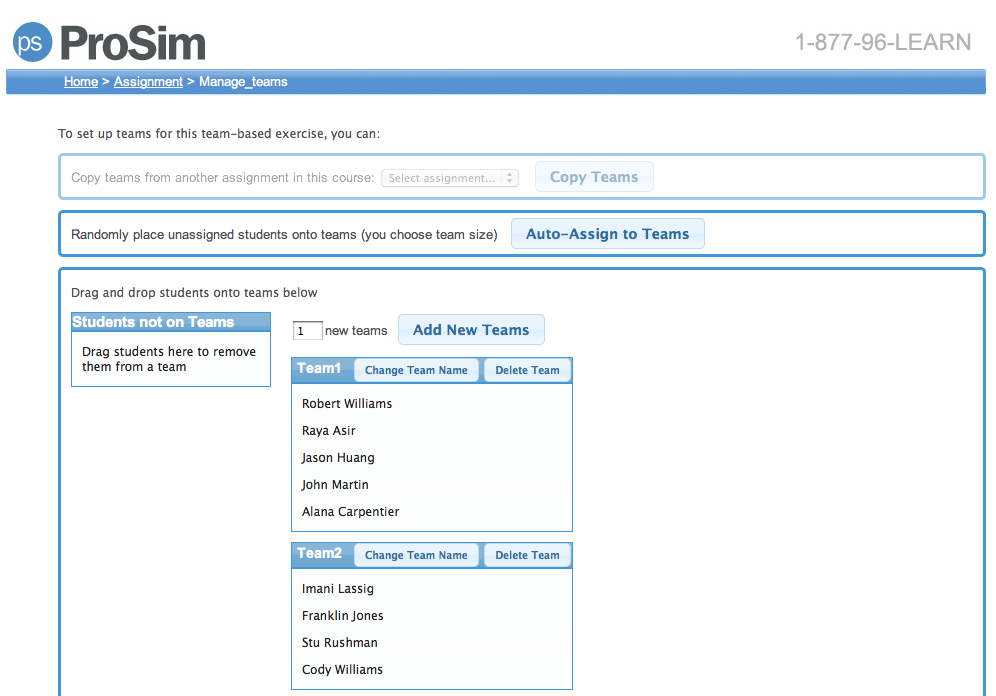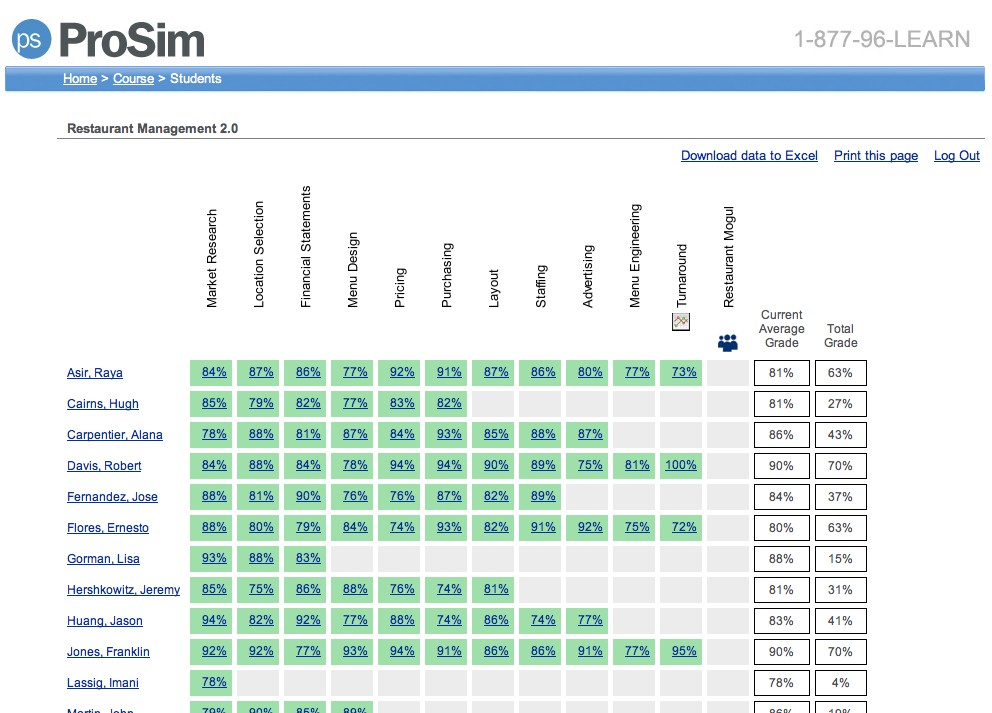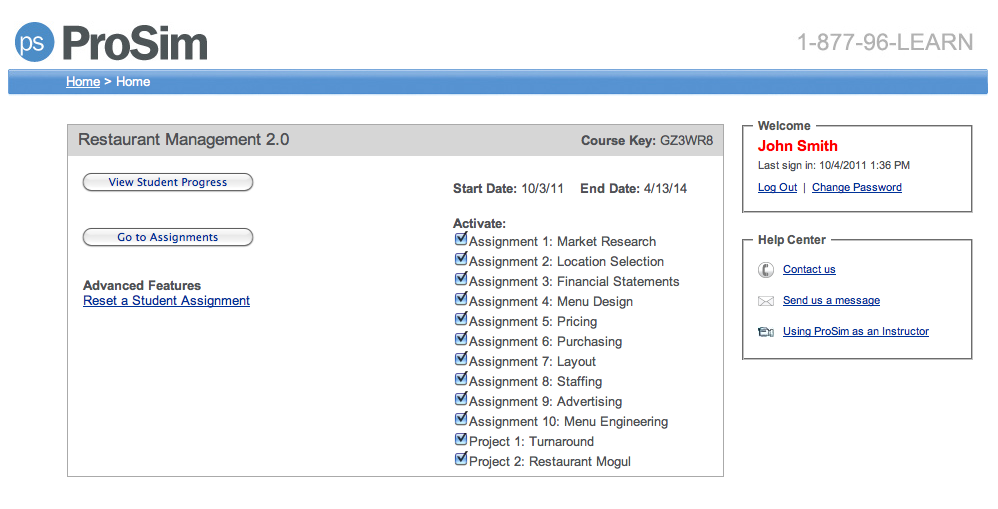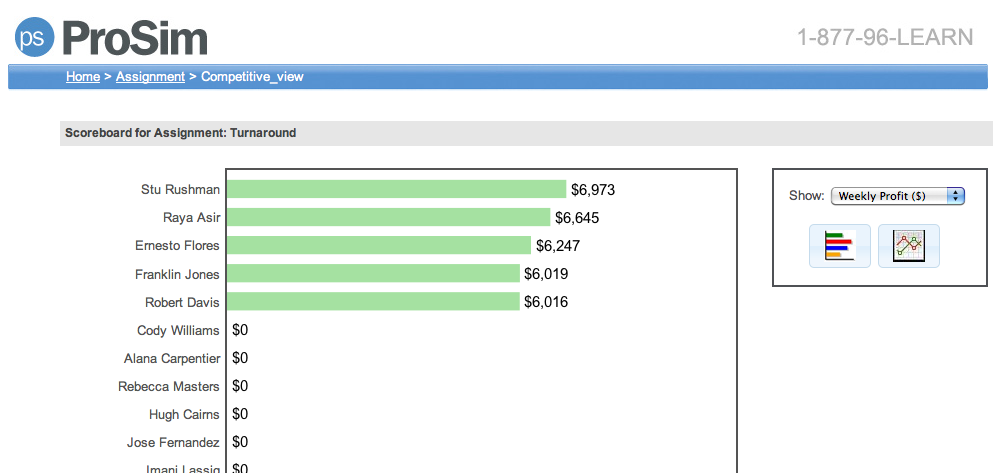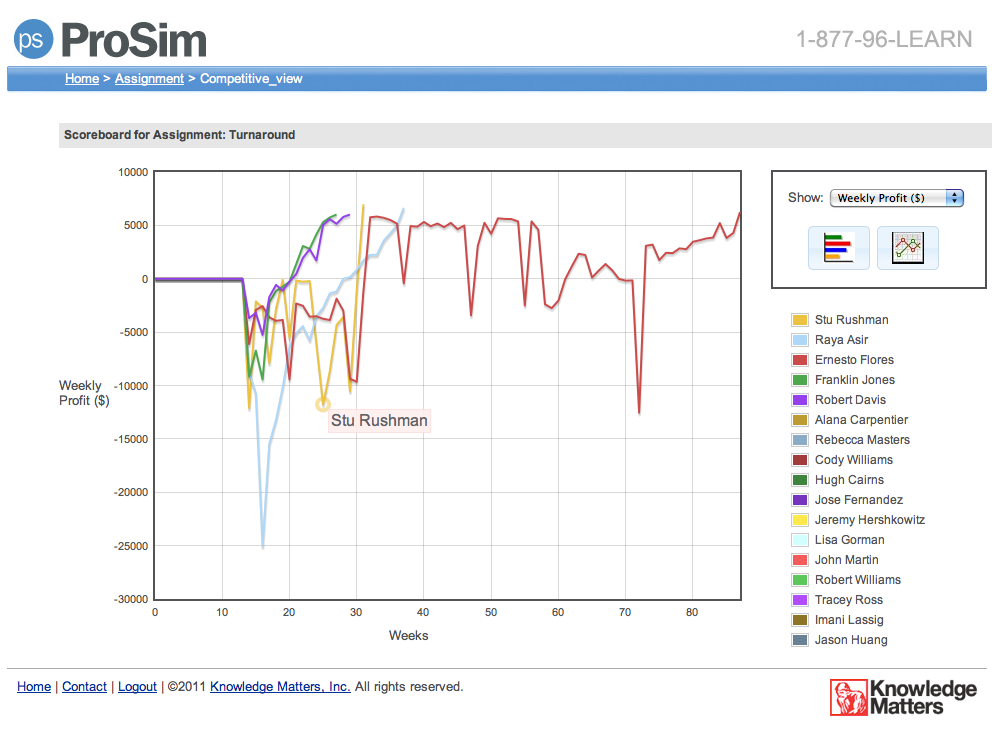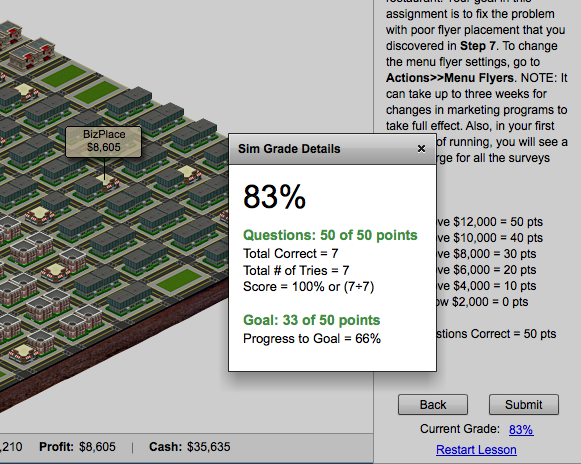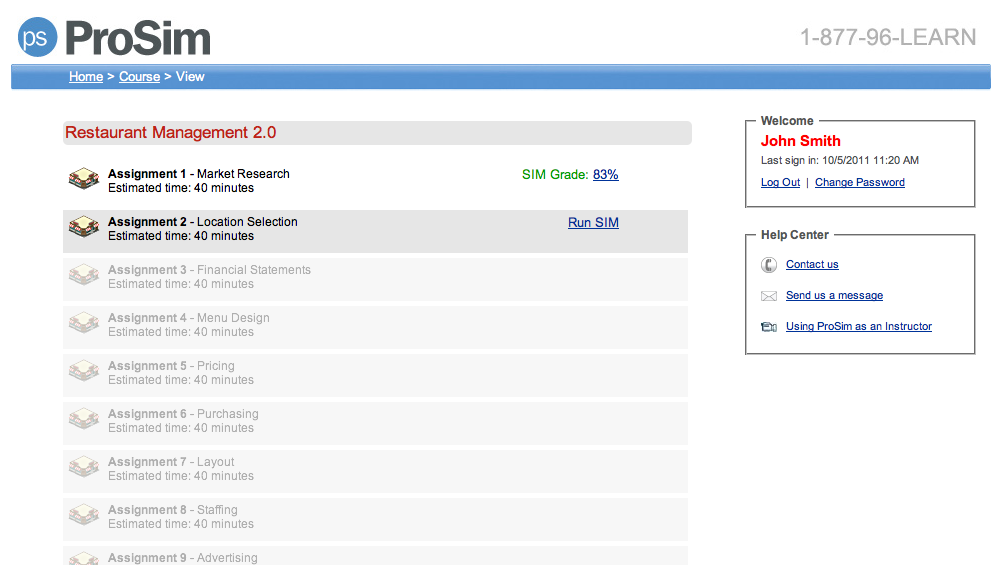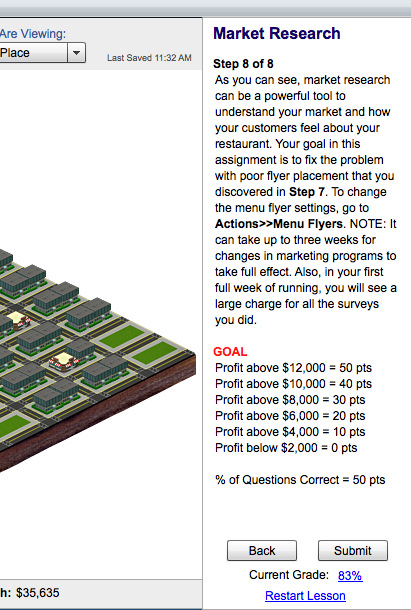ProSim Restaurant

Keep your eyes open for a great new revision of ProSim – Restaurant as it joins our new Case Simulations format as the Restaurant Collection of Case Simulations. Coming Soon.
Incorporate online simulations into your current curriculum with ProSim – Restaurant. You can include just one simulation assignment into one course, multiple assignments and projects across multiple courses, or build an entire course around all the ProSim – Restaurant assignments and projects. ProSim – Restaurant is perfect for courses such as Intro to Hospitality, Restaurant Management, and Food & Beverage Operations, and comes with all the class management and assessment tools that you need, and we offer FREE phone and email support.
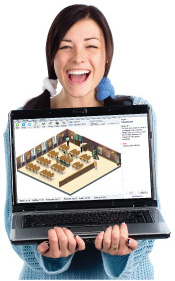
Assignments & Projects List
ProSim – Restaurant is comprised of ten assignments and two projects that focus on different aspects of the business of running a restaurant. You may combine these to create a custom course for your students. You may include as few or as many assignments and projects as you like. The assignments and projects that you choose may be put in any order you like, and are priced individually, with discounts given as you include more assignments or projects within a course. All assignments and projects come with detailed student pre-reading (see sample) that introduces students to the concepts that will be covered.
Assignment
Market Research
Students explore the use of surveys as a key market research tool. Students select questions for a survey and analyze the results presented in bar graph form. Students then segment their survey data (select respondents by their answer to a particular question), then analyze the characteristics of a sub-group of the population. Students use market research to diagnose a marketing problem and then are challenged to solve the problem.
ESTIMATED TIME FOR COMPLETION: 40 Minutes PRICE: $4.99
Assignment
Location Selection
Students take over a struggling restaurant and seek to move it to a better location. They learn how to determine if rents for a property are reasonable given the revenue potential of the area. Students estimate revenue potential from population data and market research data on customer spending habits. Students then use their analysis to find a location that generates profits above a series of target thresholds.
ESTIMATED TIME FOR COMPLETION: 40 Minutes PRICE: $4.99
Assignment
Financial Statements
Students will read an income statement and identify revenue, profit, and gross margin. Students will compare gross margin to industry benchmarks to identify and solve a problem. Students will read a balance sheet and combine balance sheet data with income statement data to create a key operating metric. Finally, students will use the income statement to identify and solve an expense problem and increase profit.
ESTIMATED TIME FOR COMPLETION: 40 Minutes PRICE: $4.99
Assignment
Menu Design
In this assignment, students use customer observations and sales reports to identify problems with a menu. Students use surveys and segmentation analysis to redesign the menu. They also use menu matrix analysis to design a more efficient menu. By changing the order of items on the menu, students boost the sales of high margin items. Finally, they adjust both the entree menu and beverage menu to reach a profit goal.
ESTIMATED TIME FOR COMPLETION: 40 Minutes PRICE: $4.99
Assignment
Pricing
Students learn how to price menu items. They learn how to price based on food cost and then adjust for items that can command higher or lower margins. Students explore price elasticity of demand and cross-elasticity of demand among products. They conclude the assignment by setting menu prices to achieve a profit goal.
ESTIMATED TIME FOR COMPLETION: 60 Minutes PRICE: $4.99
Assignment
Purchasing and Inventory Control
Students learn how to set initial purchasing levels based on forecasts of capacity, table turns, entree sales, and ingredient usage. They then adjust purchasing of some ingredients that are selling out and causing customer dissatisfaction. Next, they adjust for different sales volume by day of the week to dramatically reduce waste from perishables that expire. Finally, students take over the purchasing for a second restaurant and manage purchasing to reach a profit goal.
ESTIMATED TIME FOR COMPLETION: 60 Minutes PRICE: $4.99
Assignment
Layout
Students identify problems with their configuration of tables and solve these problems to decrease wait times and improve sales. They then identify problems with their kitchen layout based on employee feedback. Students rearrange the kitchen to eliminate bottlenecks. They then observe how the lack of adequate equipment can affect customer satisfaction ratings. Students calculate the required equipment based on load forecasts and throughput capacities. Finally, they take over control of the layout at a second restaurant and apply their knowledge to reach a profit goal.
ESTIMATED TIME FOR COMPLETION: 40 Minutes PRICE: $4.99
Assignment
Staffing
Students fix staffing problems at a restaurant that is badly overstaffed. They use the income and industry cost benchmarks to calculate the magnitude of the overstaffing problem. Students then estimate the number of customers for the busiest night. Based on estimates of what different staffing positions can handle per person, they will calculate the number of staffers needed at each position. Students then observe problems that can result from understaffing. Finally, they use what they have learned to set proper staffing levels for all days of the week to reach a specific profit goal.
ESTIMATED TIME FOR COMPLETION: 40 Minutes PRICE: $4.99
Assignment
Advertising
Students begin by establishing an initial marketing budget based on the current revenue and industry benchmarks for marketing spending. They then identify a particular target customer demographic and look at media options for reaching that demographic through advertising. Students compare the cost of advertising options to their budget to determine if they are affordable. Finally, students add other media into their marketing mix to reach a specific profit goal.
ESTIMATED TIME FOR COMPLETION: 40 Minutes PRICE: $4.99
Assignment
Menu Engineering
In this assignment, students learn how to increase the gross margin and profit of their restaurant by grouping menu items into categories based on their unit sales and margin. They learn to identify Stars, Dogs, Puzzles, and Plow Horses among their menu items. For each category, students learn what to do with those items to improve overall margin and profitability. Finally, they take over the menu at a second restaurant and use their knowledge to increase its profit to a specific goal.
ESTIMATED TIME FOR COMPLETION: 40 Minutes PRICE: $4.99
Project
Turnaround
Students take over a struggling restaurant and restore it to profitability. To achieve this, they follow a systematic approach to identifying and solving problems. This approach is presented as a diagnostic flow chart. Students look sequentially at generating customer demand, fulfilling customer demand, and then fulfilling customer demand cost effectively. Finally, they apply their knowledge and the diagnostic process to turnaround a second struggling restaurant.
ESTIMATED TIME FOR COMPLETION: 2 to 4 Hours PRICE: $9.99
Project
Restaurant Mogul
In this project, students will open multiple restaurants and build a profitable restaurant empire. They begin by following a series of steps to open their first restaurant. These include market research, location selection, menu design, pricing, purchasing, layout, staffing, and advertising. After following the steps, students have created a restaurant that is generating revenue but operating at a loss. They will improve profitability by listening to customers and controlling costs. A troubleshooting flowchart is available if needed. After making their first restaurant profitable, students open one or more additional restaurants to reach a total profit goal for their empire.
ESTIMATED TIME FOR COMPLETION: 3 to 6 Hours PRICE: $14.99
Assessment & Teaching Tools
ProSim – Restaurant comes with a complete suite of teaching tools designed specifically for colleges and universities. The assignments and projects are all online, allowing for extensive student tracking. Student progress and grades, may be easily monitored online by the professor. There are even charts and reports to help compare a student’s progress to other students within his/her class.
There are also plenty of assessment tools to make sure you and your students understand how they are doing. Students are quizzed as they proceed through all assignments and projects, and are automatically graded. The hands-on portion of the simulation is also auto-graded. The students grades may be seen inside the sim, so students know how they are doing. All the students’ grades may be viewed online, by the professor. There is even an actions journal that logs every action and decision that a student has made, with a timestamp.
Textbook Correlations
ProSim – Restaurant may be used in conjunction with many different textbooks. Below you will find correlations to four restaurant management and operations textbooks. The correlations show you which assignments and projects are appropriate to include with each chapter of the textbook. If you do not see the textbook that you currently use and would like to request a correlation please email your request to ginley@KnowledgeMatters.com.
The Restaurant: From Concept to Operation
By John R. Walker; Publisher: Wiley
| Chapter | Assignment(s) | Project(s) |
|---|---|---|
| 1. Introduction | ||
| 2. Kinds and characteristics of restaurants and their owners | ||
| 3. Concept, location, and design | · Location Selection | |
| 4. Restaurant business and marketing plans | · Market Research · Advertising | |
| 5. Financing and leasing | ||
| 6. Legal and tax matters | ||
| 7. The menu | · Pricing · Menu Design · Menu Engineering | |
| 8. Bar and beverages | ||
| 9. Food purchasing | · Purchasing | |
| 10. Planning and equipping the kitchen | · Layout | |
| 11. Restaurant operations and control | · Turnaround · Restaurant Mogul | |
| 12. Organization, recruiting, and staffing | · Staffing | |
| 13. Employee training and development | ||
| 14. Service and guest relations | ||
| 15. Restaurant technology |
Restaurant Operations Management: Principles and Practices
By Jack D. Ninemeier, David K. Hayes; Publisher: Prentice Hall
| Chapter | Assignment(s) | Project(s) |
|---|---|---|
| 1. Introduction to Restaurants and the Restaurant Industry | ||
| 2. The Restaurant Manager and Sanitation | ||
| 3. The Restaurant Manager and Safety | ||
| 4. Nutrition Basics | ||
| 5. Marketing | · Advertising · Market Research | |
| 6. Menu Planning, Design, Pricing, and Evaluation: Where It All Starts | · Pricing · Menu Design · Menu Engineering | |
| 7. Managing the Restaurant’s Human Resources | ||
| 8. Accounting and Financial Management | · Financial Statements | |
| 9. Standard Recipes Implement Quality Food Production | ||
| 10. Purchasing, Receiving, Storing, and Issuing: Getting Ready for Production | · Purchasing | |
| 11. Managing Food Production | ||
| 12. Managing Beverage Production and Service | ||
| 13. Food and Beverage Service | ||
| 14. Labor Cost Control Standards | · Staffing | |
| 15. Revenue Collection and Control Systems | ||
| 16. Restaurant Analysis and Improvement Procedures | · Turnaround | |
| 17. Legal Aspects of Restaurant Management | ||
| 18. Restaurant Layout and Equipment | · Layout | |
| 19. Restaurants and the Banquet Business | ||
| 20. Engineering and Facility Maintenance |
Restaurant Management: Customers, Operations, and Employees, 3rd Edition
By Robert Christie Mill; Publisher: Prentice Hall
| Chapter | Assignment(s) | Project(s) |
|---|---|---|
| 1. Introduction | ||
| 2. Understanding the Customer | · Market Research | |
| 3. Developing A Marketing Plan | ||
| 4. Promoting the Operation | · Advertising | |
| 5. Pricing and Designing the Menu | · Pricing · Menu Design · Menu Engineering | |
| 6. Delivering Quality Service | ||
| 7. The Physical Facility | ||
| 8. Food and Beverage: From Supplier to Customer | · Purchasing | |
| 9. Kitchen Equipment and Interiors: Selection, Maintenance and Energy Management | · Layout | |
| 10. Sanitation and Food Safety | ||
| 11. Controlling Costs | · Financial Statements | |
| 12. Employee Selection | · Staffing | |
| 13. Training and Development | ||
| 14. Motivating the Employee | ||
| 15. Restaurant Manager 2010 | · Turnaround · Restaurant Mogul |
Successful Restaurant Management: From Vision to Execution: 1st Edition
By Donald Wade; Publisher: Cengage Learning
| Chapter | Assignment(s) | Project(s) |
|---|---|---|
| 1. Introduction to the Restaurant Business | ||
| 2. Menu Design and Engineering | · Pricing · Menu Design · Menu Engineering | |
| 3. Marketing | · Market Research · Advertising | |
| 4. Site Selection | · Location Selection | |
| 5. Business Plan | · Restaurant Mogul | |
| 6. Finance and Accounting | · Financial Statements | |
| 7. Building the Restaurant | · Layout | |
| 8. Sanitation Management | ||
| 9. Operations and Analysis | · Purchasing and Inventory Control | |
| 10. Human Resource Management | · Staffing |
Try a FREE Assignment
In this trial assignment, you will explore pricing items in a restaurant. You will price items based on food cost and then adjust for items that can command higher or lower margins. You will also explore price elasticity of demand and cross-elasticity of demand among products. You will conclude the assignment by setting prices in your restaurant to achieve a profit goal. Please review the Student Pre-Reading before starting the assignment.
Price & Setup Your Class
ProSim – Restaurant is comprised of a series of assignments and projects. Use the tool below to find out the cost of a particular set of assignments and projects. As you add more assignments and projects, the discount increases. You can set up ProSim – Restaurant as a student purchase from our website, via PayPal, or through your bookstore. Discounts are available for institutional purchases.
